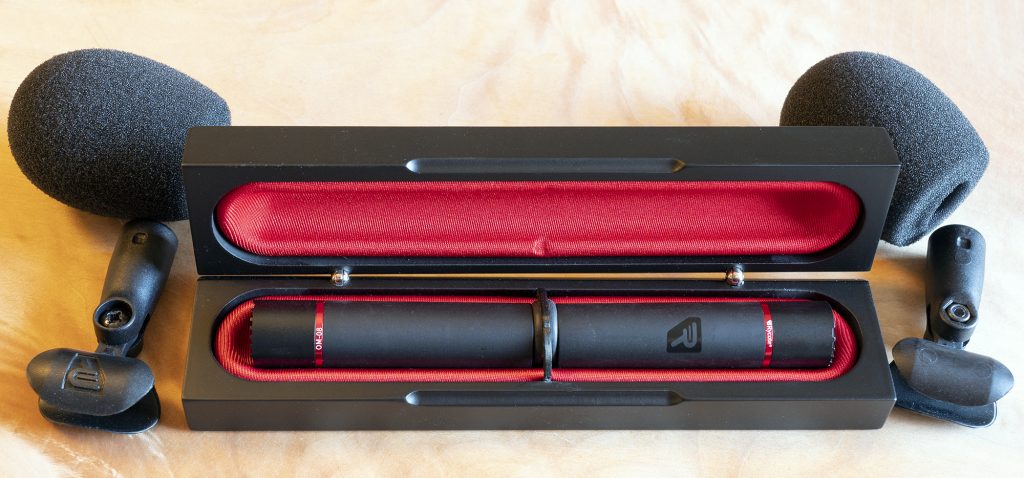
Following on from part one of my tests and review of Rycote’s new mics, it’s now time – in part two – to turn attention to their new omni mic: the OM-08. A pair of these arrived from the folks at Stroud a bit after the cardioid mic (CA-08) and the supercardioid mic (SC-08), hence the separate blog post. Much of what I said about the cardioid and supercardioid mics applies equally to the omni mics: again the specs of the OM-08 can be read on the manufacturer’s website; physically they are pretty much identical (although, being omni they lack the slots to the rear of the diaphragm); ditto for handling noise and RFI (excellent in both cases); and, as you’d expect with an omni, the OM-08 fares still better with wind. Self-noise is also excellent at 11dBA (compared to the 12dBA for the supercardioid mic and 13dBA for the cardioid mic): and, again, this figure seems to be spot on. So what’s left to test with the third of the new mic models? Plenty still, fortunately, so here goes:
A bit of music
First up, I headed down to visit guitarist Luke Chapman in his workshop (by day Luke is a woodcarver) to make a series of tests. The first one is comparative: it alternates between a pair of the Rycote omni OM-08 mics and a pair of Rode NT55 mics (with the omni capsules: that is, the NT45-O capsules, which sound a lot nicer than the cardioid capsules – indeed, the omni capsule is even rated by such luminaries as Tony Faulkner). The second test sets a single OM-08 to record the guitar, then compares it to progressively narrower-patterned Rycote mics (the cardioid, supercardioid and shotgun mics) with the distance increased proportionally to reflect the polar patterns of each. And the third test is just a longer clip of an OM-08 pair on the guitar. As expected, and this is no disrespect to the omni capsule of the NT55, the Rycote OM-08 holds up well to my ears; and the OM-08 matches well with the other Rycotes.
For those of you wanting a musical comparison with a higher-end mic and, indeed, without the audio compression that comes with YouTube, it’s on now to some WAV files of tests of a church organ. With Norwich Cathedral organ (my easiest to access test instrument) currently in pieces at Harrison & Harrison’s workshop in Durham, I thought about local parish churches nearby and remembered that Heydon church organ (a Wordsworth and Maskell instrument from 1883) has just been restored, so with the permission of the incumbent, I headed off with old friend and organ recordist Jake Purches of Base2 Music for a bit of testing. Jake brought a pair of his Sennheiser MKH 8020 omni mics along for comparative purposes. Five such omnis form the core of Jake’s rig for his recordings of the likes of organists Jean-Paul Imbert, Darius Battawalla and Wayne Marshall and they provide a sterner comparison than the Rode NT55 mics: and, of course, Jake is a tougher critic of the mics on such a source.
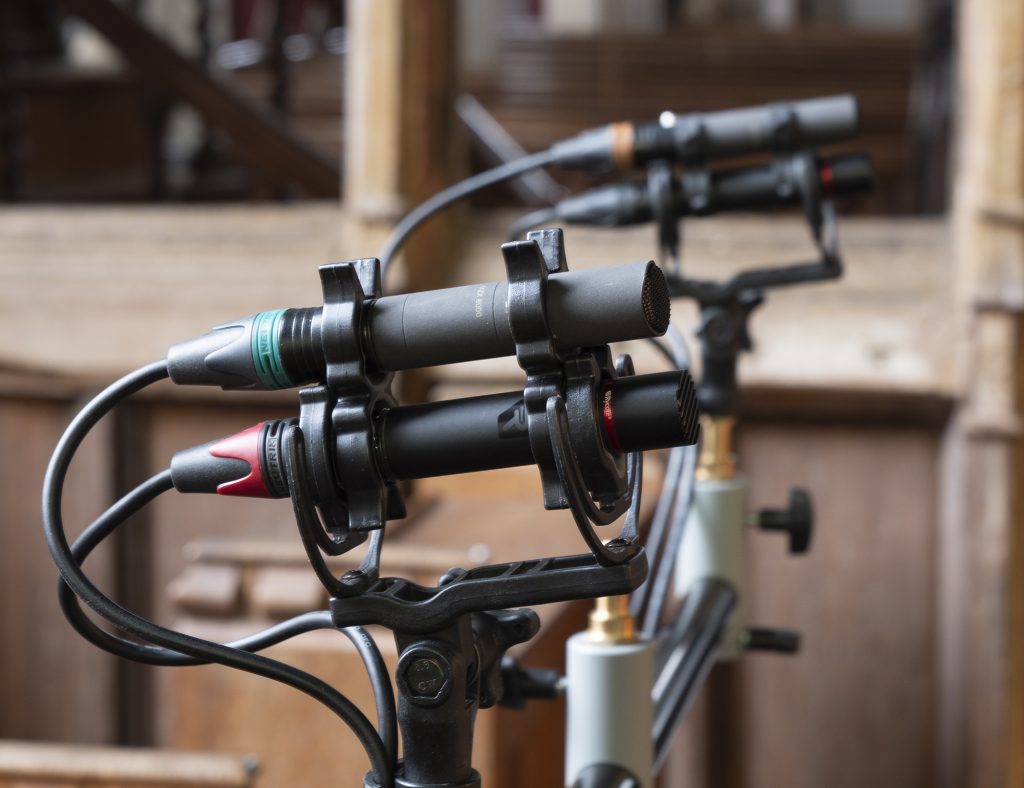
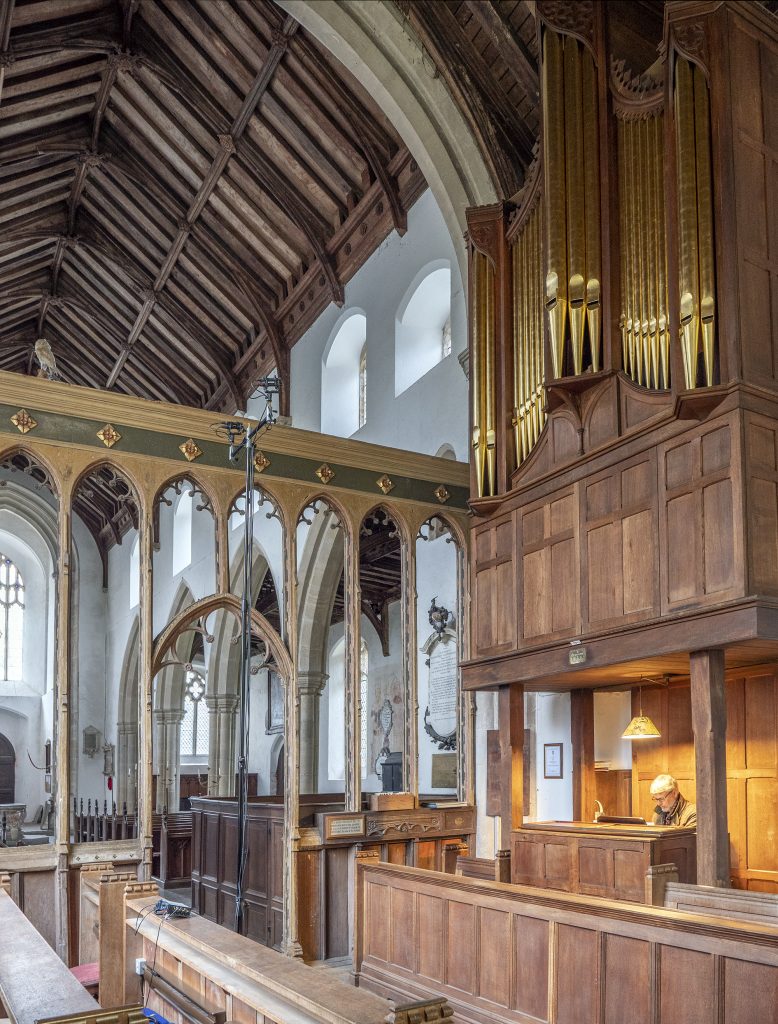
Amongst the various bits of playing of the Heydon organ, I think this simple test (running down to C1 at 32Hz) is more instructive than, say, a snippet of Bach:
Again, the Rycotes held up well in the comparative test (crucially in their low colouration, which seemed as low as that of the MKH 8020 mics), and it was revealing that after this and other tests over a couple of days, Jake is now keen to add a pair to his collection for organ recording.
Field recording
Omni mics, of course, lend themselves to field recording of ambiences as much as to music recording, so, with that in mind, I stuck a pair in blimps alongside the Sennheiser MKH 8020 mics again: the spacing was 62cm. Here, from the front garden in my ostensibly quiet Norfolk village is a bit of Sunday afternoon late November ambience: cars passing, people walking and jogging by (OK, that was me), someone playing an electric guitar in the distance, plus the odd bird that forgot to migrate to somewhere more appealing.
Again, no obvious lack on the Rycote omni mic recording – at least to my ears. I recorded the street ambience at a higher sample rate than I usually choose (96kHz instead of 48kHz: note Soundcloud seems to limit recordings to 48kHz) to allow comparison of the higher frequency response: the Sennheiser MKH 8000 series mics are known for their extended high end (amongst other attributes) and it is interesting to see how the OM-08 mics handle those frequencies above human hearing.
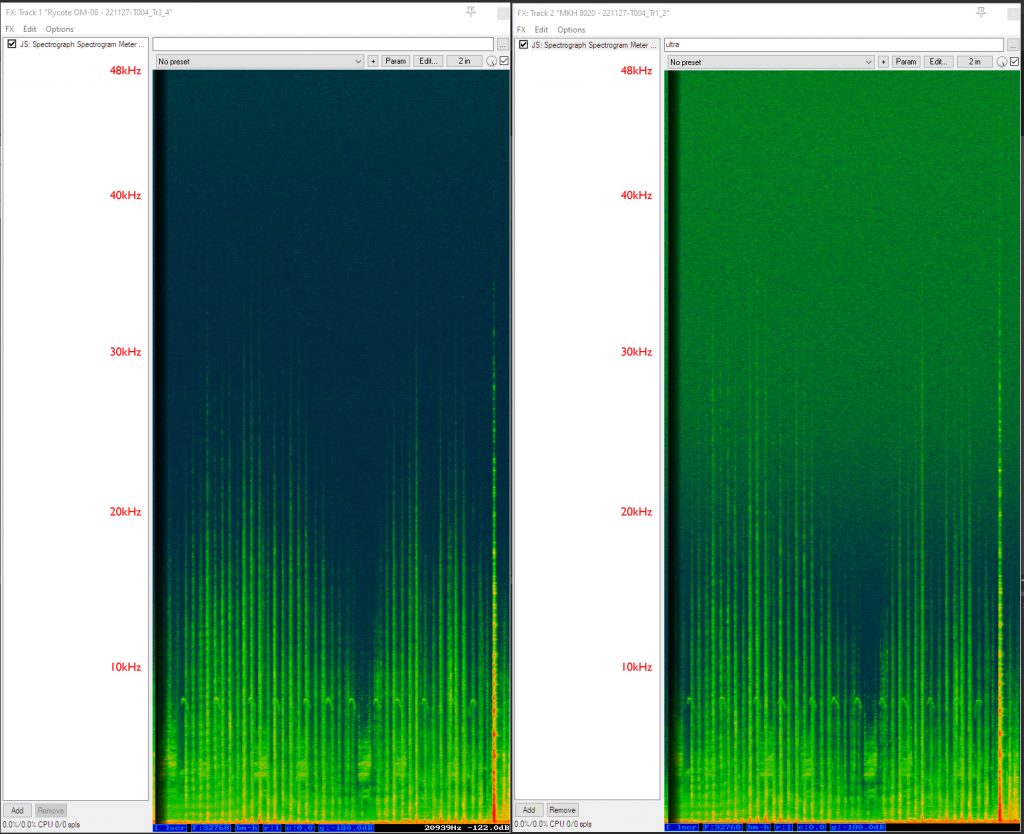
The spectrograms are revealing: they show the extended high-frequency response of the MKH 8020 with, for example, the gate-shutting sound (that tall spike near the right-hand side of the spectrograms) reaching about 45kHz, compared to about 40kHz on the OM-08 (sorry, it is clearer in Reaper on my PC than in this rather smaller derived image), which is still very respectable. More significantly, perhaps, the spectrograms show the much higher self-noise of the Sennheiser mic at high frequencies: the Rycote mic is consistently low in terms of self-noise up to the top of the graph (around -120dB at 48kHz, vs around -105dB for the Sennheiser MKH 8020). Of course, both mics deliver low self-noise in the human audible range, so this might seem entirely academic outside those recording at high sample rates and pitching down in post (e.g. for bat recordings, or for sound effects): but there are those that argue frequency response over 20kHz is important for high-resolution recording (such as David Blackmer of Earthworks mics in this article). If so minded, there is no doubt that the Rycote omni is a respectable performer over 20kHz, with much lower self-noise a useful benefit of the not quite as far extended high-frequency range. NB, if you are wondering, I checked the cardioid (CA-08) and supercardioid (SC-08) mics alongside the OM-08 (at a sample rate of 192kHz, and using a can of compressed air as a broadband source) finding they have almost identical high-frequency capability: not at all surprising given the common design of the mics.
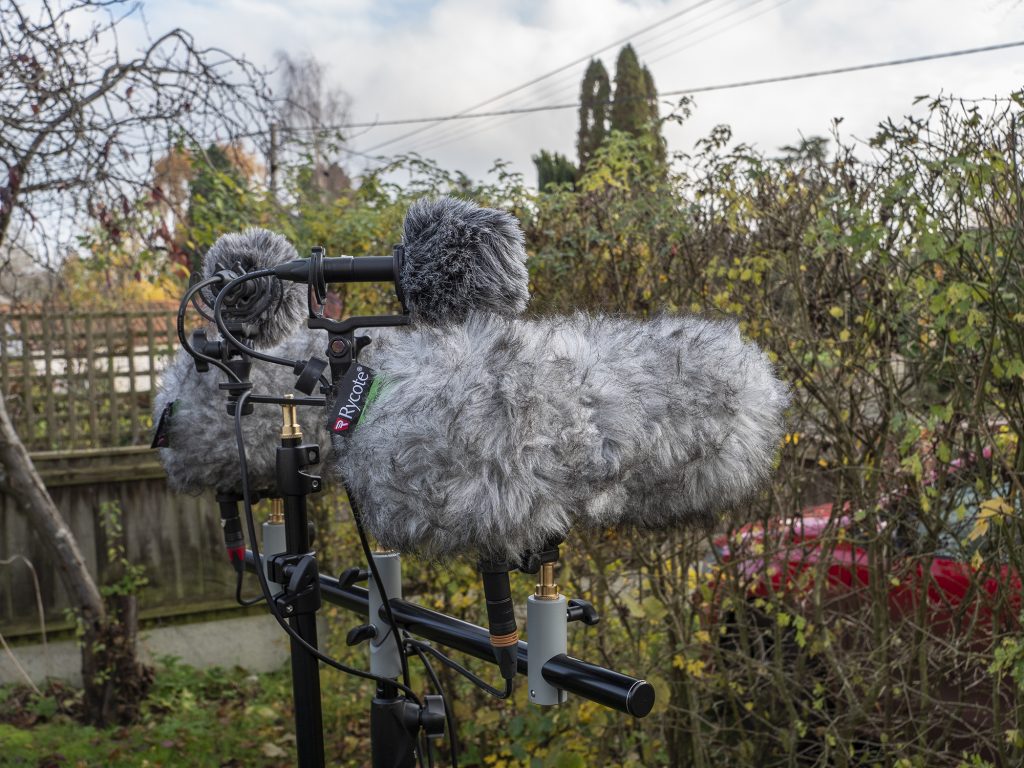
Anyway, returning from such rarefied matters to another more earthy test: this time yet another street ambience (sorry if the sound of my village street is getting too familiar to you) comparing a Rycote OM-08 omni spaced pair (at 46cm) with the Rycote CA-08 cardioid mics as a NOS pair (i.e. at 90 degrees and 30.5cm spacing). As you would expect, there is a significant difference in the bass response with the omni mics, and, of course, the impact of polar pattern and mic array on a 360 degrees ambience is much more marked than the change of a polar pattern of a mono mic recording a point source (such as in the guitar example earlier in this post): in short, these differences mean it is harder to hear the sonic consistency that is evident across the various Rycote mics.
Final thoughts
Mic choices are often made on the basis of cost, habit, familiarity, reputation, and even snobbery as much as by critical (blind) listening of all the options out there, so it is hard for a new manufacturer to establish itself. In this case, Rycote is helped by having such a long-established reputation as a maker of mic windshields and suspensions. The folks at Stroud would hardly risk that reputation on some mediocre mics, but, nonetheless, I have been slightly surprised by how good the mics all sound. As have those others – from professional sound-recording perspectives – who have kindly helped with parts of my testing. Perhaps the surprise is to some degree a consequence of the pricing – significantly below many of the established professional SDC mics made by the likes of Schoeps and Sennheiser. The two parts of these tests, covering the supercardioid, cardioid and, in this second post, the omni mics from Rycote have hopefully provided the reader with an idea of the three new mics. As I said in the conclusions to part one, these mics are a great follow-up to the HC-15 and HC-22 shotgun mics (for which see my initial review and subsequent field recording tests). All five mics merit consideration by anyone planning to buy mics in the mid range to professional categories, especially if low self-noise, a consistent sound across different polar patterns, and, indeed, availability of a range of different polar patterns are desirable. The last point is interesting: I have no inside knowledge of what is planned in terms of any future mics at Rycote, but the closing comment from Steve Phillips (Innovation Manager at Rycote) in a video about the SC-08, CA-08 and OM-08 is a tantalizing ‘I’m sure there is more to come’. Some might hope that means a wide cardioid, but, above all, I’d love to see a fig 8 mic added to the series with decent self-noise and at this price point: that would really round out the family and make the Rycotes even more serious contenders! In the meantime, I’d recommend that you try and give the mics a listen and see what you make of them too.
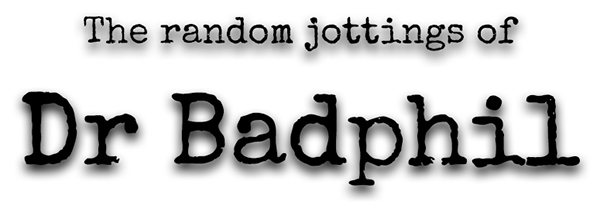

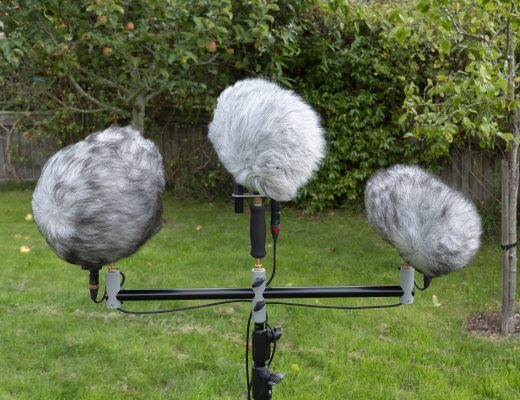
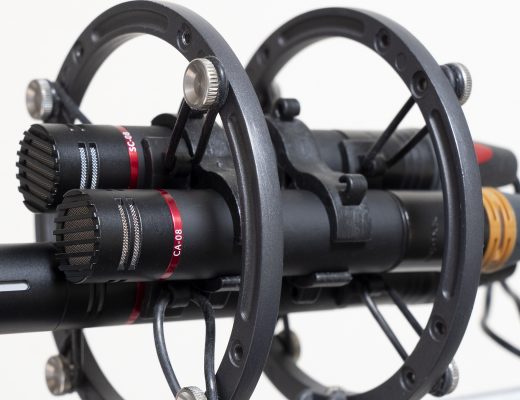
14 Comments
I would really love to see a figure-8 mic from rycote so we can utilise some of the offerings in different configurations like MS and maybe even a DMS set up that we can put together with a Rycote cyclone.
Hi Roland,
Very interesting review, especially since I never heard about these 3 new appealing mics from Rycote before !
Listening carefully to your samples, it seems to my ears that the OM-08s exhibit a slightly higher self-noise than the MKH 8020s, am I right ?
If yes, I wonder if they would be a big improvement compared to my current rode NT5s equipped with NT45-O capsules, in term of noise floor ?
If I had the chance, I would be really interested to hear a noise floor comparison between both mics, or/and to get your advice about this subject !
Also, I wonder how these OM-08s would compare to the Audio-Technica AT4022s ? Despite their self-noise of 13dBA, some people say that ATs are as silent as the MKH 8020. What is your opinion about that ? Do you think the small OM-08s would be better than the bulkier (but cheaper) AT4022s ?
Actually, I’m seriously thinking to improve my recording kit. I was wondering about the AT4022s. But these new OM-08s make me think twice !
Thanks in advance for your reply, and sorry for my bad English !
Kevin
Thanks Kevin. The self-noise difference is subtle between the OM-08 and the MKH8020, but, you are right, there is a very slight difference (as indeed their – accurate – specs suggest). Both are noticeably quieter in terms of self-noise vs the NT5/55 with NT45-O capsule if you are recording something extremely quiet, but whether or not that would be noticeable for what you record I have no idea. I haven’t used the AT4022, but have read good things: but then you could say the same about the NT45-O, which Tony Faulkner rates. I wouldn’t obsess about a couple of dB self-noise here or there. Other things matter more perhaps: e.g. are you after a diffuse field omni or a free field mic.
Sorry not to be much help!
Cheers,
Roland
Hi Roland ! Thank you very much for your reply !
Yes, you’re right, I forgot to mention that I’m an amateur field recordist ! So, I’m looking for a diffuse field response microphone. In that matter, I’m quite satisfied with the results I get with the NT5s + NT45-O, which electric noise blends quite well in most of the ambiences I record. But in some critical circumstances like quiet nature atmosphere, even a couple of dB can make a difference.
So, having a limited budget, I was first looking at AT4022s, which appear to be quiet, but are a bit bulky, maybe not so reliable in bad weather conditions as it’s not RF condenser, and sound a bit dull to my ears, at least through the samples available online. (Of course, I could probably solve that with a bit of eq, but I’m afraid I’ll raise the hiss as well.)
Then, thanks to your article, I discovered tese OM-08s, which are very appealing (small, lite, with a very pleasant sounding), but a bit over my initial budget…
So, that’s why I try to get as much information as possible, because I don’t want to go wrong !
Kevin
Hi Kevin,
RF mics are certainly your best bet in extreme humidity, but many other mics cope well in non-tropical environments: the problem is often overstated. Certainly in the often damp UK I have had no such problems with field recording with any mics, including LDCs. Anyway, this is rather academic if the OM-08s are stretching your budget then the MKH8020s will do so even more! The AT 4022s have a good reputation, but I’m not certain that you will find them a huge step-up for your purposes from the NT45-O capsules on your NT5s. Good luck with your dilemma…and with your recordings!
Cheers,
Roland
Hi again Roland !
Yes, even if I would be very interested to get my hands on some pairs of MKH mics, I must admit that they are way over my budget, at least for now !
Well, I can confirm that NT5s usually cope quite well with moderate humidity, but I remember having some unpleasant pops in a beautiful dawn recording made in the French mountains, which made me a bit disappointed. Hopefully, it never happened again !
As I’m not sure that using at4022s would really improve my current omnis setup too, I think I’ll probably go to these nice small OM-08s.
In any case, thank you very much for your attention ! Nice to chat with you about this inspiring subject !
Have a nice weekend !
Cheers,
Kevin
Hi Kevin,
Well if you do go with the OM08s I hope you enjoy using them as much as I have: I’ve found them excellent.
Cheers,
Roland
Hello Roland !
Well, finally, I ordered a pair of OM-08s ! I received them two days ago, and did some short recordings and quick comparison with my Rode NT5s + NT45-O… I must say that these small Rycote mics are really nice : very detailed, rich, and way more natural sounding than the Rode ! Amazing, and very promising !
(In addition, I like their diminutive size, and the flattering box in which they come. So British !)
Once more, thank you very much for your review and advice !
Definitely, the CA-08s are the next item on my wish list !
Wishing you all the best,
Kevin
Hi Kevin,
Good to hear that you are liking your OM-08s: great mics indeed!
Cheers,
Roland
[…] response found in testing of the other Rycote SDC mics. As with the comparison of the Rycote OM-08 and Sennheiser MKH8020 omni mics for extended high frequency response, I recorded a street ambience at 96kHz instead of 48kHz, in […]
Hi Roland, after reading your review, I’m looking to purchase the CA-08 to pair with the MKH8030 for a DMS setup (I mainly record ambient sounds in my daily use). Since buying the MKH8040 is currently a bit over my budget, what do you think of this combination? Thank you very much for your advice.
Hi Oliver,
I have no particular view on the combination of the CA-08 and the MKH 8030. Although I have the whole series of Rycote mics, and all the MKH 8000 mics except the MKH 8070 (long shotgun), I don’t mix and match: rather, for MS, I stick to the BD-10 + other Rycote mics, or the MKH 8030 and other Senneheiser MKH 8000 mics. Generally it’s a good principle to pair mics from the same series to get a better match, although, of course, unless using a fig 8 for the mid mic too, then the frequency response will be a little different across different polar patterns anyway. I’m not certain if you have the MKH 8030 already: if not, and if budget is limited, I would suggest considering buying the BD-10 and a matched pair of CA-08s, so you can use the CA-08 for non-MS stereo recording too; or consider buying the BD-10 and one CA-08, along with one or two other polar patterns (OM-08 and/or SC-08). I’d rather have more mid mic options than just one mid mic and a more expensive fig 8. And don’t underestimate/discount MS with an omni mid mic.
Cheers,
Roland
Hello,Roland,Thank you so much for your reply and suggestions. I already own the MKH 8030 – I’ve been using it paired with the MKH 416 for MS recording. Currently, my options for DMS microphone combinations are quite limited. If I go for the MKH 8000 series, the new microphones are overly expensive: in my country, a matched pair of MKH 8040 costs over 3,500 US dollars. As for used ones, I can only find the unimproved versions, and their quality is hard to guarantee. So I’m still looking for the right microphones. If you don’t recommend pairing it with the CA-08, do you have any better suggestions? Thanks again for your reply.
Hi Oliver,
All I was saying was that, despite (or, rather, because of) having all the mics in question, I pair MKH 8030 with other MKH 8000 mics; and I pair the Rycote mics with the Rycote BD-10. To do otherwise would seem odd given that it is preferable to match mics as well as you can for MS (and therefore DMS), insofar as different polar patterns allow. I don’t think that, if not going for MKH 8040s, that any other more affordable cardioid would be better than the CA-08, so, given the budget constraint, it wouldn’t be a bad choice. And the CA-08 + MKH 8030 for MS or DMS will be a lot better than with the MKH 416 (unless the priority with the latter is mono dialogue, with just the occasional use of stereo ambience).
Since my last reply, I have remembered that I did test the CA-08 with the MKH 8030, although this was a test focused on comparing the MKH 8030 and the Rycote BD-10: https://drbadphil.com/sennheiser-mkh-8030-part-2-mid-side-recording
Cheers,
Roland